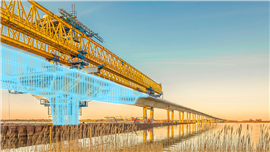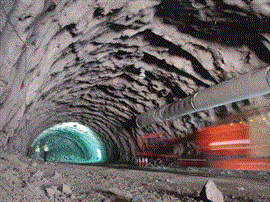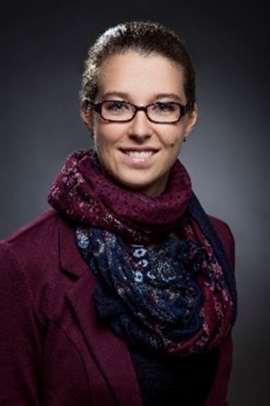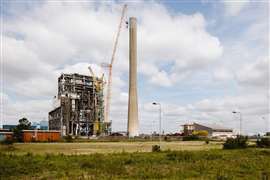A shift in positioning: ultra-wideband technology
04 September 2023
In the ever-changing landscape of construction, embracing technological advancements is vital for success.
 Accurate measurements are essential to the successful implementation of digital twins in construction. Image: Bentley
Accurate measurements are essential to the successful implementation of digital twins in construction. Image: Bentley
As the industry undergoes digital transformation, Ultra-Wideband (UWB) technology is emerging as a powerful tool.
A recent technological breakthrough promises to elevate precision and efficiency to new levels.
Today, data is the currency that drives innovation and efficiency. For the construction industry, the availability of accurate and real-time data holds the key to optimising processes and achieving seamless coordination.
Position data, in particular, is crucial for ensuring that construction projects stay on track and that resources are utilised effectively. The concept of a digital twin, a virtual representation of a physical asset, is gaining prominence in construction and industrial processes.
However, for the digital twin to truly mirror reality, precise and reliable measurements and positioning data is essential. This is where UWB technology steps in as a game-changer.
Exposing the limits of GPS
The limitations of existing technologies have been a bottleneck for achieving the level of accuracy required in construction projects. While GPS is effective outdoors, it falters in indoor, tunnel, and underground settings.
Laser-based positioning is constrained by environmental factors such as dust and dirt, leading to inaccuracies and thus, the need for repeated measurements. Bluetooth technology conserves energy but has limited range and security risks, while Wi-Fi excels in speed and coverage but lacks precision.
Although optical systems offer pinpoint accuracy, they show significant disadvantages concerning installation complexity, environmental factors, and privacy issues.
UWB technology is being hailed as the next major wireless innovation in the market. Its advantages extend beyond data collection to secure data transmission, making it a comprehensive solution for the construction industry.
 Taking accurate measurements can be a challenge when working inside tunnels
Taking accurate measurements can be a challenge when working inside tunnels
What sets UWB apart is its ability to provide accurate positioning and communication indoors, independent of GPS signals. Distance and angle measurements between UWB sensors are not only feasible but also cost-effective.
‘Swiss Army Knife’ technology
Unlike laser systems, UWB is independent of line-of-sight, resilient in adverse conditions and offers minimal radiation exposure. More advantages like limited interference, enhanced data security, versatility, and real-time tracking capabilities position UWB as a transformative solution for enabling precise and efficient operations across various scenarios.
As the “Swiss Army Knife of Technologies”, UWB attracts attention from various sectors. However, despite its potential, precision in positioning has remained an obstacle. Previous attempts by research institutions and semiconductor manufacturers to enhance accuracy fell short of achieving the desired results.
Until now. A German startup has succeeded in shifting the existing limit a hundredfold: It improved positioning precision from several centimetres to less than one millimetre. The innovative power behind this breakthrough in basic research is enormous.
Innovation for structural safety
The establishment of this new benchmark has opened doors to applications across markets that were once inconceivable. Achieving sub-millimetre precision in controlling large construction machines or precisely aligning large components such as bridge segments is not only feasible but also relatively easy.
 Dr Vera Thome of LaterationXYZ
Dr Vera Thome of LaterationXYZ
This new level of precision also sets the direction in the field of Structural Health Monitoring (SHM): Small sensors, installed or retrofitted at neuralgic points in objects such as bridges, can continuously record the finest vibrations in the substance in real time. Irregularities in the individual vibration behavior of the structures allow conclusions to be drawn about material weaknesses.
Predictive maintenance and minimally invasive repairs can then prevent unnecessary demolitions or even collapses. In addition to ensuring the safety of individuals, SHM represents a significant stride toward sustainability by also protecting existing objects and infrastructures.
The technology is not only suitable for maintaining existing structures but also significantly enhances efficiency during the construction phase. In the realm of Building Information Modelling (BIM), precise positioning improves process coordination and unveils planning errors in the millimetre range, which is beneficial for quality management.
Accuracy in all environments
The sensors can also provide objects with reliable self-verification from the outset of construction. Furthermore, this technology is already finding application in IoT scenarios. When combined with sensors integrated into the building, structures gain a highly accurate self-awareness, paving the way for a new generation of smart buildings.
Especially in areas with limited or absent GPS signals, the technology enables highly precise distance measurements. Intuitive operation is also quick and easy for untrained personnel. Additionally, angle measurements are easily achieved. In contrast to conventional laser systems, transmission via radio waves allows for the most reliable results even in dirty, dusty environments or when obstructed by obstacles.
The high precision also benefits the operation of construction machinery. Objects, vehicles, equipment and loads can be accurately localised and surveyed. This helps avoid collisions, especially in processes involving increased dynamics, such as working with cranes and machinery. When combined with personnel equipped with sensors, hazardous situations can be detected before they occur and prevented through timely warnings. These new capabilities enhance workplace safety, and improved coordination of team members facilitates progress in case of a shortage of skilled personnel.
The technology also excels in the security domain. As currently one of the most secure wireless data transmission methods, it renders interference or Man-in-the-Middle attacks nearly impossible. Additionally, multiple sensors can be used to create a virtual mesh network that reliably detects unauthorized intruders in critical areas. After the construction phase, sensor systems can contribute to burglary protection.
The boundaries of UWB technology are far from being fully explored. The newly gained technological sophistication will propel cross-industry digitization forward, establish new standards, and foster innovations. This breakthrough in key technology means acceleration and simplification of complex processes for construction 4.0. In the future, we won’t get around this technological leap. In fact, with this new precision in UWB, the construction industry is poised to advance with the digital revolution, achieving bull’s-eye results at every turn.
|
Further information LaterationXYZ is a startup specialising in localisation technology. The company was established in 2022 and is based in Ettlingen, Germany. In collaboration with NXP Semiconductors, LaterationXYZ recently demonstrated an increase in the accuracy of UWB devices to millimetre level – a significant milestone in the development of UWB technology For more information, visit www.lateration.de |
STAY CONNECTED


Receive the information you need when you need it through our world-leading magazines, newsletters and daily briefings.
CONNECT WITH THE TEAM










